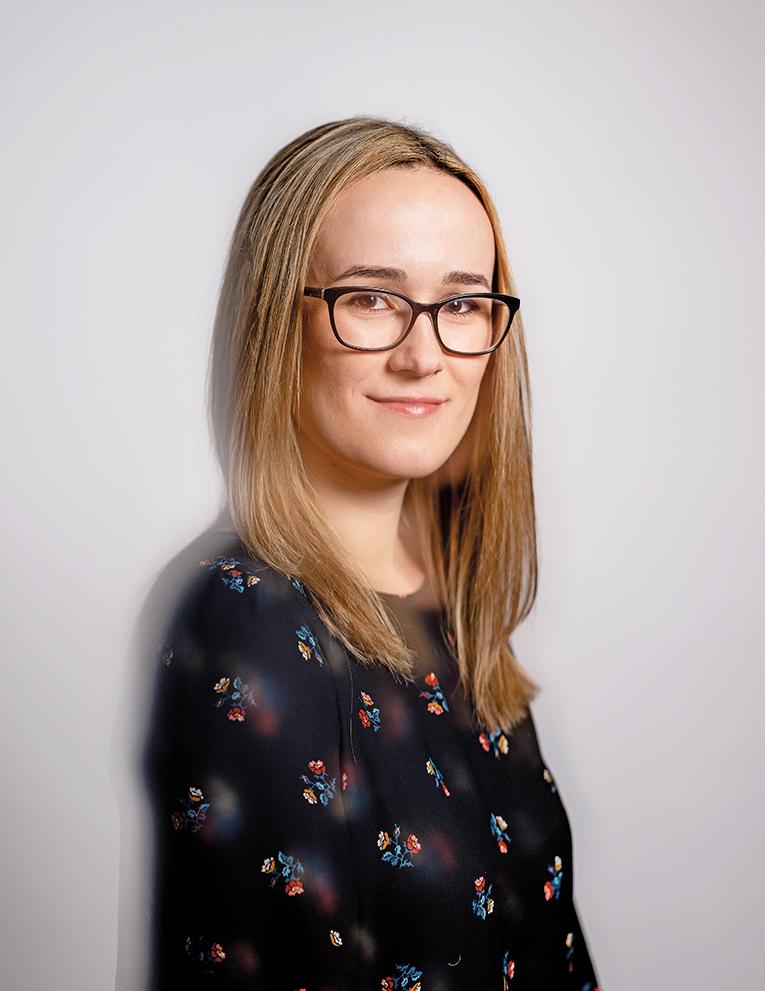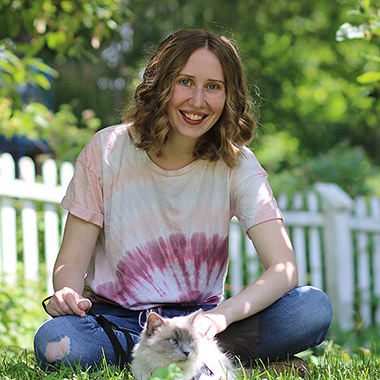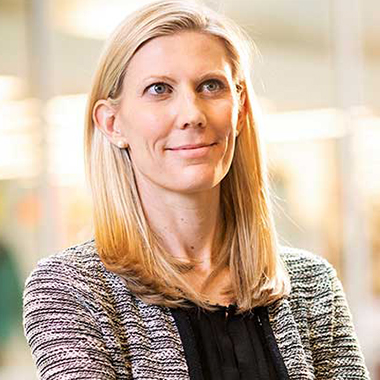Hiding No Longer
Through a new advocacy group, students like Nicole Pannullo are finding an outlet to speak openly about their conditions and to connect with other graduate students with disabilities.

Motivated by her own health condition, Nicole Pannullo is pursuing research in retinal development and regeneration.
Photography by Howard Korn
When Nicole Pannullo started her doctoral program at the Johns Hopkins University School of Medicine, she found herself reverting to old ways — hiding her disabilities.
Pannullo, a Ph.D. candidate in the Cellular and Molecular Medicine Graduate Program, has a rare genetic disease called Usher syndrome type II, which is characterized by hearing loss and progressive blindness. As an undergraduate at the Rochester Institute of Technology (RIT) — which houses an institute for the Deaf — she’d finally become open and comfortable with her identity as a person with disabilities. She’d also centered her career path on that identity, pursuing retinal research.
In her early days at Johns Hopkins, though, Pannullo felt disconnected. “One of the immediate changes was not having visible students with disabilities surrounding me and making me feel like I was part of a community,” she says.
Absent, too, were certain tools that had helped her at RIT, like captioned lectures and note-taking services. Not wanting to draw attention, Pannullo avoided requesting such accommodations at Johns Hopkins. “It felt like I needed to hide my disabilities to appear normal, and seeking those would be kind of exposing myself,” she says.
But when the COVID-19 pandemic hit, she had no other choice. With colleagues’ mouths now obscured by face masks, she could no longer rely on lip reading to fill in bits of conversations she missed due to her hearing loss. “I was having a difficult time communicating in the lab,” says Pannullo. Ultimately, she contacted Student Disability Services (SDS) and arranged for clear masks to be provided.
Sometime during that process, she learned of a group called Equal Access in Science and Medicine (EASM), a nascent effort to gather a community of medical and graduate students with disabilities from across Johns Hopkins’ East Baltimore campus. It started as a seminar series featuring disabled scientists and clinicians, with Johns Hopkins clinical psychologist Kay Redfield Jamison, who has bipolar disorder, delivering the first lecture in February 2020.
Pannullo decided to get involved.
Not So Easy

Anna Moyer, co-founder of EASM, also had experience with hiding. In her first two years as a Ph.D. candidate in human genetics at the school of medicine, she told very few peers or professors about her connective tissue disorder and the pain it caused.
When Moyer required major surgery to reshape her rib cage in 2016, she scheduled it for summer to avoid missing classes. Back in Baltimore that fall, she winced in discomfort sitting through lectures and struggled to find time for physical therapy appointments and calls to her health insurance company.
“As I’m working on my Ph.D., I’m arguing with my insurance trying to get better coverage and not really talking to my classmates about the fact that I was dealing with all this on top of the normal things in your Ph.D. that are supposed to be hard,” she says.
We're all busy people juggling our work and our own disabilites; we don't have a lot of time as it is. So even just a few chances to connect are so helpful, honestly."
Alexandra DiTommaso
Moyer and others describe “a culture of excellence” in graduate school that compels many to put on their best fronts. “You’re expected to not only succeed but also make it look easy,” Moyer says. “If you’re not the prototypical thriving student, it can feel like you’re not fit for this environment.”
That pressure can also be internal, notes Erica Avery, an early leader of EASM, who earned her Ph.D. in cellular and molecular physiology in 2023. Avery, who has fibromyalgia, remembers one predawn struggle during college when she knew she needed emergency care. “I was lying in bed at 4 a.m. in so much pain, thinking, OK, can I make it through my 8 a.m. class and then go to the ER, because I can’t miss that class,” she says.
EASM members say that formally requesting accommodations for disabilities can be a tricky matter — “even though it’s not a favor being asked. It’s federal law to comply,” Pannullo says. “But it takes a lot of energy to advocate for yourself.”
For Moyer, it was the sudden death of a classmate in 2019 — a woman who had kept her autoimmune disease private — that jolted her into a new mindset. She was done with the secrecy. She wanted to speak openly about her condition and to connect with other students with disabilities.
When Moyer contacted Student Disability Services at Johns Hopkins, she learned that only a handful of students were registered for accommodations. “And I thought, that just can’t be right,” she says. “There are disabled students; we just don’t know about them.”
That disparity mirrors national trends in the STEM fields. While people with disabilities constitute the largest minority group in the U.S., an estimated 27% of the population, they represent only a 3% proportion of the STEM workforce.
Working with other disability-focused groups and offices at Johns Hopkins, Moyer and her classmate Claire Bell conceived of the Equal Access in Science and Medicine seminar series — a chance for students with disabilities to converge, regardless of whether they wanted to disclose their disability.
“The thought was that maybe if students had the opportunity to see you can be successful as a disabled scientist, to see role models, that would raise morale among disabled students,” Moyer says, “and eventually, you’d have some kind of community.”
Connection Points

Equal Access in Science and Medicine continued to evolve after Moyer and Bell graduated, cementing as a support structure, social touchpoint and advocacy arm for Johns Hopkins graduate students with disabilities in the schools of medicine, public health and nursing. A Slack channel hosts online chatter among about 70 members, while a small core committee organizes funding and events, and coordinates with other Johns Hopkins entities.
The group hosts an X (formerly Twitter) page and various gatherings — including a past Wikipedia edit-a-thon to shore up references to disabled scientists and a screening of Crip Camp, the 2020 documentary about a group of disability rights advocates who first met at summer camp. EASM is also working to build a stronger network with Johns Hopkins alumni with disabilities, with the hope of creating mentoring opportunities.
“We’re all busy people juggling our work and our own disabilities; we don’t have a lot of time as it is. So even just a few chances to connect are so helpful, honestly,” says Alexandra DiTommaso, a second-year Johns Hopkins medical student who has chronic pain due to a genetic disease.
Among the group, disabilities vary widely and include mobility issues, hearing or vision impairment, chronic pain, and mental health conditions. Some disabilities are visible, some are not; some are life-dominating, and some flare up from time to time.
While all are welcome, the group right now is almost uniformly composed of women. “What you’re seeing is a reflection of the reality, of who’s ‘out’ with their disability,” says Bonnielin Swenor, a valued mentor to the group and director of the Johns Hopkins University Disability Health Research Center. “We talk about this [phenomenon] all the time in disability communities,” says Swenor, a national leader in disability research and advocacy, who has low vision and trained at Johns Hopkins herself in the early 2000s.
She and others speculate that this gender disparity stems from biased societal views of disability as weakness. “With the traditional masculine identity, you’re not supposed to show vulnerability,” she says. Overall, Swenor says, there is “a lot of work to do to foster inclusion and success of disabled people in STEM, including better support for people of color and LGBTQ people with disabilities in these environments.”
Some EASM members are active in disability justice issues outside of Johns Hopkins — penning articles, taking part in panels, and joining national groups and associations, for example. DiTommaso has become vice director of education for Medical Students with Disability and Chronic Illness, which has chapters across the country. Avery spoke last June on a National Academies panel about disrupting ableism and wrote a viewpoint for Scientific American in which she advocated for more inclusive environments for scientists with disabilities.
Changemakers
At the school of medicine, the number of students receiving accommodations through Student Disability Services has soared over the past four years, suggesting more comfort in making those requests. In 2019, only three medical students were affiliated with SDS, according to Ellen Kaplan, the school’s assistant director of SDS. Today, there are 45. Between all medical, graduate and Ph.D. students, 114 total are receiving accommodations this year, up from 74 in 2021.
Equal Access in Science and Medicine exists within a web of groups and offices around The Johns Hopkins University and the school of medicine that focus on disability issues. In 2019, the university hired Catherine Axe, its first-ever executive director of Student Disability Services, to oversee disability services across the institution.
Axe, who have worked with EASM, says the group’s advocacy and input has helped “spark a growing range of programs and initiatives focused on disability,” and their input has been critical for efforts like interviewing candidates for new positions serving students with disabilities.
Students have more power to create change than they often realize — and making a change at an institution like ours, the best research institution in the country, is significant."
Bonnielin Swenor
Last spring, EASM steered listening sessions at the medical school to highlight how certain tools that went mainstream during the pandemic — including more recordings, captions and remote options — could remain beneficial in the long term for some students with disabilities.
Swenor says in her time at Johns Hopkins, she’s witnessed “remarkable and noticeable” progress on disability rights issues on campus.
“A few years ago, it was far too rare that a group of students with disabilities could succeed in calling the attention of leaders from across a university and for their requests to be taken this seriously,” she says. “Students have more power to create change than they often realize — and making change at an institution like ours, the best research institution in the country, is significant.”
Experience Wanted
A central tenet driving EASM is the belief that science and medicine benefit from the contributions of disabled scientists and doctors — especially those bringing personal experience to the conditions they study or treat.
One lecturer EASM hosted, Avery recalls, was Deaf otolaryngologist Chad Ruffin, who shared obstacles he encountered with his disability. “With his deafness, society didn’t provide him an inclusive path to becoming a doctor,” she says. “But this is a Deaf man who wants to devote his life to helping other Deaf people. This should be the goal! It shouldn’t be rare.”
Pannullo — who completed two internships at the National Eye Institute at the National Institutes of Health and is now pursuing lab research at Johns Hopkins studying retinal development and regeneration — has found that most people are excited to hear that she’s both a patient and scientist in her field. “Obviously, I’m very passionate about it because of my own experiences,” she says.
With Usher syndrome type II, Pannullo knows that as her sight worsens, she’ll require more supports in her career. “Wanting to continue this direction of research, I know my role will change as my career and my disease progress, and it’s going to make sense to have certain accommodations,” she says. “Having to navigate that in real time, and prepare for that, is something I’m thinking about a lot lately as I head out of grad school.”
Through EASM, Pannullo recently connected with another Johns Hopkins student who has the same rare diagnosis as she does. “I definitely would not have met them had I not been part of this group,” she says. “And it was really nice and encouraging to realize I’m not alone in that.”
